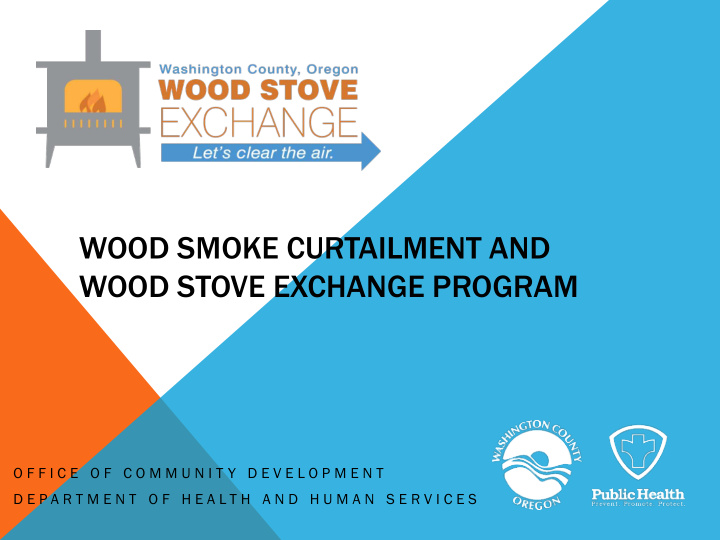



WOOD SMOKE CURTAILMENT AND WOOD STOVE EXCHANGE PROGRAM O F F I C E O F C O M M U N I T Y D E V E L O P M E N T D E P A R T M E N T O F H E A L T H A N D H U M A N S E R V I C E S
WOOD SMOKE IN WASHINGTON COUNTY
LEVELS OF FINE PARTICULATE MATTER (PM 2.5) WASHINGTON COUNTY Federal Standard eter per cubic met ms p grams Microgr
WOOD SMOKE AND HEALTH
WOOD SMOKE CURTAILMENT ORDINANCE
WOOD STOVE EXCHANGE PROGRAM GOALS • Assist families relying on wood burning for heat • Perform outreach and raise awareness • Educate on clean burning • Exchange 700 stoves • Prevent emissions of particulate, harmful gasses and pollutants
WOOD STOVE EXCHANGE PROGRESS TO GOAL
PARTICULATE PREVENTED 450 35.0 400 30.0 29.1 350 25.0 300 20.0 250 Stoves Exchanged 200 15.0 150 10.0 Particulate 100 Pollution Prevented (Tons) 5.0 50 0 0.0
EMISSIONS PREVENTED TO DATE Pollutant Emissions Prevented (tons) TONS PM2.5 + PM 10 29.12 Carbon Monoxide (CO) 106.41 Methane 29.77 Volatile Organic Compounds (VOCs) 26.41 Total HAPS (Hazardous Air Pollutants) 2.47 Sulfur Dioxide (SO2) 0.14 Nitrogen Oxides (NOX) 1.15 from U.S. EPA Emissions Calculator Total emissions prevented 195.45 Wood smoke particulate, harmful gases, VOCs, and HAPS
DEQ INDOOR AIR QUALITY STUDY • A collaborative effort between Portland State University, the Washington County Department of Health, and the Washington County Office of Community Development to assess the impact of the Washington County Woodstove Exchange Program (WSE) on indoor and neighborhood air quality. • 20 homes participated • 15 involved basic monitoring – indoors and outdoors • Monitoring for particulate matter. • 5 homes opted for enhanced monitoring – indoors and outdoors • With additional monitoring for compounds associated with wood-burning: carbon monoxide, black carbon, and aerosol optical properties associated with biomass burning.
DEQ INDOOR AIR QUALITY STUDY FINDINGS • Comparing air quality levels only during periods of woodstove use showed 12 of 17 (71%) households had reduced levels of indoor PM2.5 post woodstove exchange. • The median change in indoor PM2.5 post-exchange was -1.0 μg /m3 when the peak due to first burn is excluded. This equates to a 19% reduction of particulate (on average). • For 13 of 17 houses with data available, large transient peaks of PM2.5 (>100 μg /m3, measured via PurpleAir sensor) were observed following first stove use. Operating the newly installed stove with the home mostly unoccupied for the first burn may be considered. • Out of the five houses involved in enhanced monitoring, four had outdoor carbon monoxide levels decrease after the exchange occurred. • Out of the five houses involved in enhanced monitoring, outdoor black carbon decreased in two of the homes, and outdoor brown carbon decreased in four of the homes.
OUTREACH, EDUCATION AND AWARENESS • New educational folder • PSA’s – • TVCTV City Talk • On 4 Spanish language stations (Bustos media) • Interview on KATU “Afternoon Live”
www.WoodSt dStoveExch change.co com 503-846-4425 O F F I C E O F C O M M U N I T Y D E V E L O P M E N T D E P A R T M E N T O F H E A L T H A N D H U M A N S E R V I C E S
Recommend
More recommend